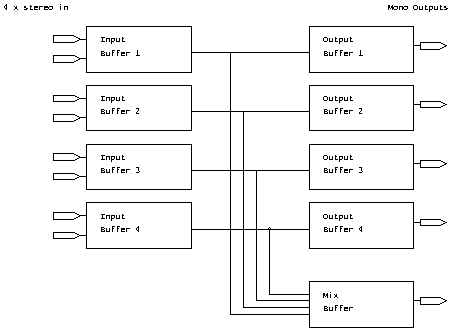As it stands, the circuit takes 4 (stereo) inputs, and provides 4 buffered (mono) outputs (these are the same as the 4 inputs, but in mono) plus a further (mono) output which is the sum of all the 4 inputs. The 4 buffered outputs are typically used for feeding to a mixing desk, whilst the sum output feeds to your station output selector switch.
The circuit is modular, so if you need fewer or more inputs, all you do is leave out, or add more buffer amplifiers. Similarly, if you need more outputs (eg to feed 2 desks) just add extra output op-amp buffers!

The 4 stereo input signals come in on the left. These are buffered. The outputs of the buffers each go to 2 places: first it goes to its own (mono) output buffer; second, it is mixed together with the other 3 inputs, and the sum of all 4 inputs is buffered and output.
There you go, 4 stereo inputs converted into 4 mono outputs, along with a mono "mix" output!.
Starting at the left of the circuit, the stereo input signals are capacitively coupled (to eliminate DC offset problems on the inputs), then mixed to mono, and buffered. It is possible to change the gain on the input buffer (eg if mixing 3 soundcards plus news, and the news is not at the same audio level) by adjusting the feedback resistor value, or even replacing it with a preset pot.
The gain of the buffer is Rf/Rin (Rf is the feedback resistor, R3, and Rin is the input resistor, R1 and R2). Currently, the circuit has a gain of 0.5 for each input... but as there are two input signals, they add together. The end result is that if you have a 0dBu signal on EACH input, then the MONO signal will remain at 0dBu. If you are only feeding in a mono signal, then you can either (a) use a single Rin, and set the gain to 1; or (b) feed the mono input to BOTH resistors (don't worry, this DOES work!)
After the input buffers, the signals go 2 ways: first of all, they are all mixed together to provide a single "station output" signal. The other way each signal feeds a further output buffer amp. The outputs are NOT capacitively coupled - if you use the specified op-amps, any DC offsets will be so small that they can be ignored. Besides, most equipment you connect the buffer unit to will have their own input capacitors.
Each buffer inverts the audio signal phase: because all audio paths have TWO buffers, the phase of all outputs is the same. "Why is this important" you may ask: well, by keeping the phase the same, it means that if you feed the signals via a desk, and then switch between the desk output and the "station output" of this buffer circuit, there should be no clicks (assuming that your mixer doesn't invert the phase!!)
Bear in mind that the summed output will be simply the sum of all the inputs: if you decide to simultaneously play out two (or more) signals, then, unless you drop both levels a bit, your output will be a bit too high (this is no different from fading up two channels on a normal mixer: if they are both "loud", the output will then be "very loud").
Do NOT use a switch-mode supply! SMPSU's often create audio noise... that's the last thing we want on this circuit! At the powers we are talking about, a linear PSU is not a big deal.
The circuit will work just as well with any supply from +/-12 volts to +/- 18 volts: the higher the supply, the more audio headroom you will have. However, make sure your op-amp IC's can take the voltage: some versions of the TL071/2/4 range only go to 15 volts)
It may be that you have a suitable PSU in another bit of equipment: if so, then you can possibly use that. The 100ma quoted above is a very conservative estimate.
If you feel up to building youir own PSU, then take a look at Article #3, which describes how to build a simple linear PSU.
The TL06x range of op-amps are low-power versions (with a matching lower performance) of the TL07x, whilst the TL08x range are a lower cost version, with a worse noise figure. Wilst they may seem to be ok, I'm not going to vouch for how they cope with longer cable runs (that comment applies especially to the TL06x range) that are often needed in radio studios.
Many other modern op-amps are also suitable: however, it is generally NOT worth paying huge amounts for "state of the art" high-spec devices: at the end of the day, your station output is feeding either (a) a BT landline, then a 100 v line amplifier and finally piezo earpieces at the patient end; or (b) a MW transmitter which is listened to on a low-grade radio ("Walkmans" may have a good FM performance, but their MW performance is usually very close to crap!). In all cases, the audio quality of the TL07x range of op-amps far exceeds the quality of all the other downstream equipment!!!! (I have won that arguament MANY times!!!)
(plb, rev 1, Sept 1999)